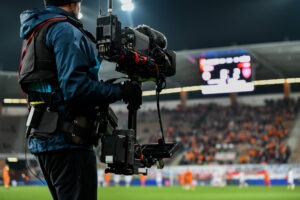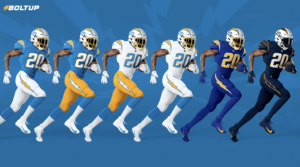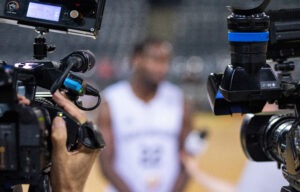Media and the PR Playbook: Strategies for Sporting Success
Published on November 6, 2023, 3:46 p.m.
by Caroline Raley.
In virtually any field, the power of public relations is undeniable, yet it shines brightest for some in the exhilarating arena of sports. Top Agency defines sports public relations as “promoting teams, individual players and sports organizations through earned media channels—including broadcast, print, radio, and online media outlets. Sports PR targets editors, producers, reporters, writers and anchors at mass media outlets.”
There are many different audiences to please when it comes to sports PR. All fans act differently depending on the sport, the city in which their favorite team is playing, and the personal lives of their favorite players. Honoring reputation is key to effective sports PR.
Ensuring social media hygiene
Boomer Dangel, vice president of broadcasting and new media at CSE, explained the importance of keeping social media clean. He talked about how athletes and sports personalities have the right to go to parties and clubs but need to “just put the phone away.” How the world sees a person can easily be twisted and ruin someone’s reputation.

Ja Morant, point guard for the Memphis Grizzlies NBA team, is a fitting example of an athlete having a destructive social media presence. In March 2023, NBC released information regarding Morant live-streaming himself holding what appeared to be a gun at a nightclub.
The occurrence of this incident couldn’t have been more poorly timed. Morant faced suspension when the team held the second position in the Western Conference. The team’s success was led by the 2019 draft pick, Morant, who had received a $194 million offer. This situation affected both his team and his own reputation. Probably advised by his PR team, Morant apologized. Morant missed eight games and lost more than $600,000 in salary. Nonetheless, Morant was suspended again for flashing a gun on social media two months later. Morant should listen to Boomer Dangel’s advice: “Just put your phone away.”
Ultimately, a spotless social media presence is crucial for an athlete to protect their image, uphold their endorsement deals and maintain positive sentiment with fans. It helps them avoid potential pitfalls and ensures a positive and lasting impact on their career and public perception.
Audience engagement and content strategy
According to Mentimeter, audience engagement is the “intentional strategy to interact with the audience and turn them from passive spectators to active participants.” Content strategy is similar in definition: It is the plan that explains how audience engagement will be achieved.
Audience engagement and content strategy are crucial to sports PR to build and maintain a strong fan base. Best practices include compelling story telling, understanding your audience, consistency in content, creating visual content, building online communities, and adapting to current events.

The Los Angeles Chargers’ X account serves as a prime example of these best practices in action. The team effectively caters to its target audience, primarily the younger Generation Z demographic. Its social media consistently features visually engaging content, showcasing exciting plays and exclusive events with coaches and players. Additionally, the page keeps its content current and relatable by incorporating popular memes that align with current events.
Publicity of NIL deals
NIL, which is short for name, image and likeness, refers to the way college athletes can receive compensation. According to Fan Arch, Arch Manning, backup quarterback for the Texas Longhorns and member of the popular football family including Peyton and Eli Manning, has an estimated NIL value of a whopping $3.8 million.
Arch Manning inked his first sponsorship deal within his first week as a college football player, generating some controversy. The Texas Longhorns swiftly responded with transparency, with head coach Steve Sarkisian reportedly indicating that Arch Manning would only receive compensation when he officially started as the quarterback.
The ongoing debate surrounding NIL deals continues to surface. Public relations professionals working with these athletes and teams should maintain an accountable approach when interacting with fans and potential brands. They should be prepared for what is to come in the near future surrounding controversial deals due to price or what a brand stands for.
Media relations
According to Everything PR, “Media relations is a company’s interactions with editors, reporters and journalists. The media can be newspapers, radio, television and the internet. The goal is to communicate a client’s newsworthy message, story or information using the appropriate media outlets.”
Dangel used Bruce Pearl, University of Auburn basketball coach, as a good example of someone who has worked with media in his favor and also not in his favor. Dangel explained how Pearl is a very “personable guy with huge personality so he is able to use media to his advantage a lot.” However, on the flip side, Pearl runs the risk of turning people off by talking about politics, most recently on Israel and Palestine. Dangel expressed how Pearl walked a fine line in situations like these, risking Pearl’s finances, endorsement deals and reputation.
Jessica Stephans, New England Patriots communication associate, explained that working with media is pivotal in her job of representing the NFL team. She stated that “the biggest thing is discovering what values are most important to athletes, then establishing and maintaining that.”
“What the media wants to see is that you respect them and their job,” she said. She added that they need to “come across as a person, not just an athlete.”
Media training
According to Rachelle Logan Media, “If you are an athlete on any scale, receiving professional media training is necessary. Media training is designed to help athletes navigate all levels of media interviews and public appearances.”
Stephans emphasized that the nature and extent of media training for athletes with the New England Patriots may vary depending on an athlete’s experience and familiarity with the team.

Stephans ensures that players and coaches are well-informed about the questions they may face, offering them guidance on potential responses. She maintains a vigilant approach, actively listening and monitoring the situation. It’s essential not to leave athletes unprepared, and in cases where they are caught off guard, the focus is on coaching them in delivering appropriate and effective responses.
Best practices for sports PR
In the dynamic realm of sports PR, the wisdom from professionals like Dangel and Stephans offers invaluable insights and advice. Dangel emphasized that keeping social media clean applies to a PR professional as well, as their digital footprint plays a pivotal role in shaping their professional image. Furthermore, he highlighted the importance of identifying one’s unique personality type and carving out a niche within the field.
Stephans noted that the world of sports PR is far from conventional. “If you want to work in sports PR, you are never going to work a normal 9 to 5,” she explained. Her guidance to someone wanting to be a sports PR professional includes taking every opportunity that comes one’s way and not hesitating to ask for things, underscoring that initiative and a proactive approach are keys to success in this field.
When it comes to looking for a job in sports PR, Stephans stressed the value of seeking feedback on one’s résumé and the interview process, emphasizing that constructive criticism can be a valuable tool for growth and improvement.
In the ever-evolving landscape of sports public relations, these best practices serve as a compass for those aspiring to thrive in this exciting and demanding industry.




